Drombeg stone circle
Drombeg stone circle (also known as The Druid's Altar), is a small (9 m (29 ft across) axial stone circle located 2.4 km (1.5 mi) east of Glandore, County Cork, Ireland.[3][4] The structure consists of 17 tightly packed stones. As an axial or "Cork–Kerry" stone circle, it contains two taller entrance stones placed opposite a recumbent axial stone. Its axis is orientated south west towards the setting sun.[5]
Ciorcal an Droma Bhig | |
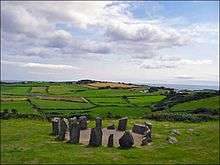 | |
 Location of site in Ireland | |
| Alternative name | Druid's Altar |
|---|---|
| Location | County Cork, Ireland Irish Grid: W245352) |
| Coordinates | 51.564553°N 9.08702°W |
| Type | Axial stone circle |
| Area | 9.3 metres (31 ft) (diameter) |
| Height | 1.8 metres (5 ft 11 in) (highest stone) |
| History | |
| Periods | Bronze Age[1] to early Iron Age[2] |
| Site notes | |
| Archaeologists | Edward M. Fahy (1957) |
| Management | National Monument Servicea |
| Public access | Yes |
| ^a Allocated National Monument number 381 | |
Although not an especially significant example,[5] Drombeg is one of the most visited megalithic sites in Ireland, and is protected under the National Monuments Act. It was excavated in 1958, when the cremated remains of an adolescent was found in a pot in the circle's center.[5]
Features
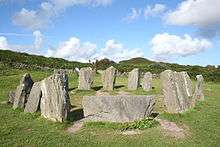
The stone circle consists of seventeen closely spaced stones spanning 9.3 metres (31 ft) in diameter, of which 13 survive. The most westerly stone (1.9m long) is the long recumbent and has two egg shaped cup-marks, one with a ring around it.[3] A "Cork–Kerry type" stone circle, it is flanked by a pair of 1.8m high axial portal stones, which provide a south-west axis, and orient the monument in the direction of the setting sun during the midwinter solstice.[2] The stones in the circle have been shaped to slope upwards to the recumbent stone, the midpoint of which was set in line with the winter solstice sunset viewed in a conspicuous notch in the distant hills. While the alignment is good, it is not precise.[6]
The ruins of two round stone walled conjoined prehistoric huts and a fulacht fiadh lie just 40m west of the monument.[7] Evidence suggests the fulacht fiadh was in use up until the 5th century AD. The larger of the huts had a timber roof supported by a timber post. The smaller hut had a cooking oven on its east side. A causeway leads from the huts to the cooking place (fulacht fiadh) featuring a hearth, well and trough in which water was boiled by adding hot stones.[3]
Excavations
Following a number of surveys in the early 1900s,[8] the site was excavated and restored in 1957.[2] Radiocarbon dating of samples taken from the site suggest that it was active c. 1100 - 800 BC. An inverted pot, found in the centre of the circle, contained the cremated remains of a young adolescent wrapped with thick cloth. The pot was buried near the centre of the circle along with 80 other smashed sherds, four bits of shale and a collection of sweepings from a pyre.[6]
Gallery
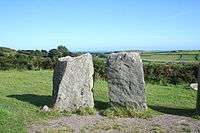 Portal stones
Portal stones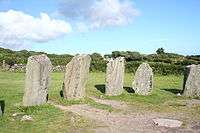 Eastern part
Eastern part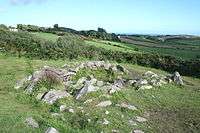 Cooking place
Cooking place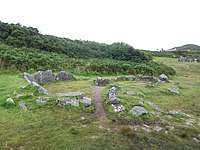 Dwelling remains
Dwelling remains
References
Notes
- Louise Roseingrave (11 December 2014). "Was Drombeg's stone circle designed using skills learned in Babylon?". Irish Times. Retrieved 7 April 2015.
- E.M. Fahy (1959). "A Recumbent-stone Circle at Drombeg, Co. Cork". Journal of the Cork Historical and Archaeological Society. 2. LXIV: 1–27.
- Anthony Weir (1980). Early Ireland. A Field Guide. Belfast: Blackstaff Press. pp. 114–115.
- Anthony Weir (2008). "Drombeg". The Megalithic Portal. Retrieved 11 June 2008.
- Noonan, 85
- Stone Pages (2011). "Drombeg stone circle, Co Cork". Stonepages.com. Retrieved 6 January 2017.
- Damien Noonan (2001). Castles & Ancient Monuments of Ireland. Arum Press. p. 85. ISBN 1-85410-752-6.
- Jackie Keogh (4 January 2017). "New discoveries about Drombeg Stone Circle". Southern Star. Retrieved 6 January 2017.
Sources
- Noonan, Damien. Castles and Ancient Monuments in Ireland. Arum Press, 2001. ISBN 1-8541-0752-6
External links
| Wikimedia Commons has media related to Drombeg stone circle. |